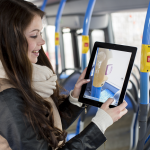According to Forbes, customer experience is the “cumulative impact of multiple touchpoints” over the course of a customer’s interaction with an organization. In public transport, a typical path is: passenger deciding to make a journey, planning of this journey, travelling to a stop or station, acquisition of a ticket, waiting, boarding a vehicle, possible changes of vehicles, alighting, and traveling to the final destination. These steps need to be closely studied to understand passenger needs. Then, this understanding can be used to manage and optimize the user experience. HSL and Data Rangers have developed digital methods for customer research and customer experience management.

Customer research (CR) is supported in three ways. The first is a set of digital customer surveys tools. We have conducted studies by disseminating unique cardboard flyers that invite passengers to web based surveys. The unique codes in the flyers allow high traceability of the collected data. We have a digital interview platform usable e.g. through iPads. And we have a mobile application allowing willing passengers to be invited to fill a survey during their journey. The application allows us to know that person X is at a vehicle Y allowing us to focus our research in selected customer types and selected situations. The second way to support customer research is automated statistical analysis of the results. E.g. the t-testing and ANOVA allows the user to find the customer groups and questions that contain the most interesting information. The third way to support customer research is web based reporting allowing company internal and external persons to access results real time.
Customer experience management (CEM) is supported by creating tasks based on research results. This process works in three levels. The first is digital recording of quality anomalies, where an employee inspects a vehicle by filling a digital survey, complete with pictures. This step could also be performed by a passenger. Second, the server traverses the results, creates tasks for bus operators and notifies selected personnel to start the work. The third level is for high level management of HSL and operators to study the results and manage the quality work. This process of inspection and task creation is applicable to many business processes.
Antti Vuorela, Head of Operational Research, Helsinki Region Transport (HSL), Finland
_Sampsa Laine, CEO, Data Rangers Oy, Helsinki, Finland
